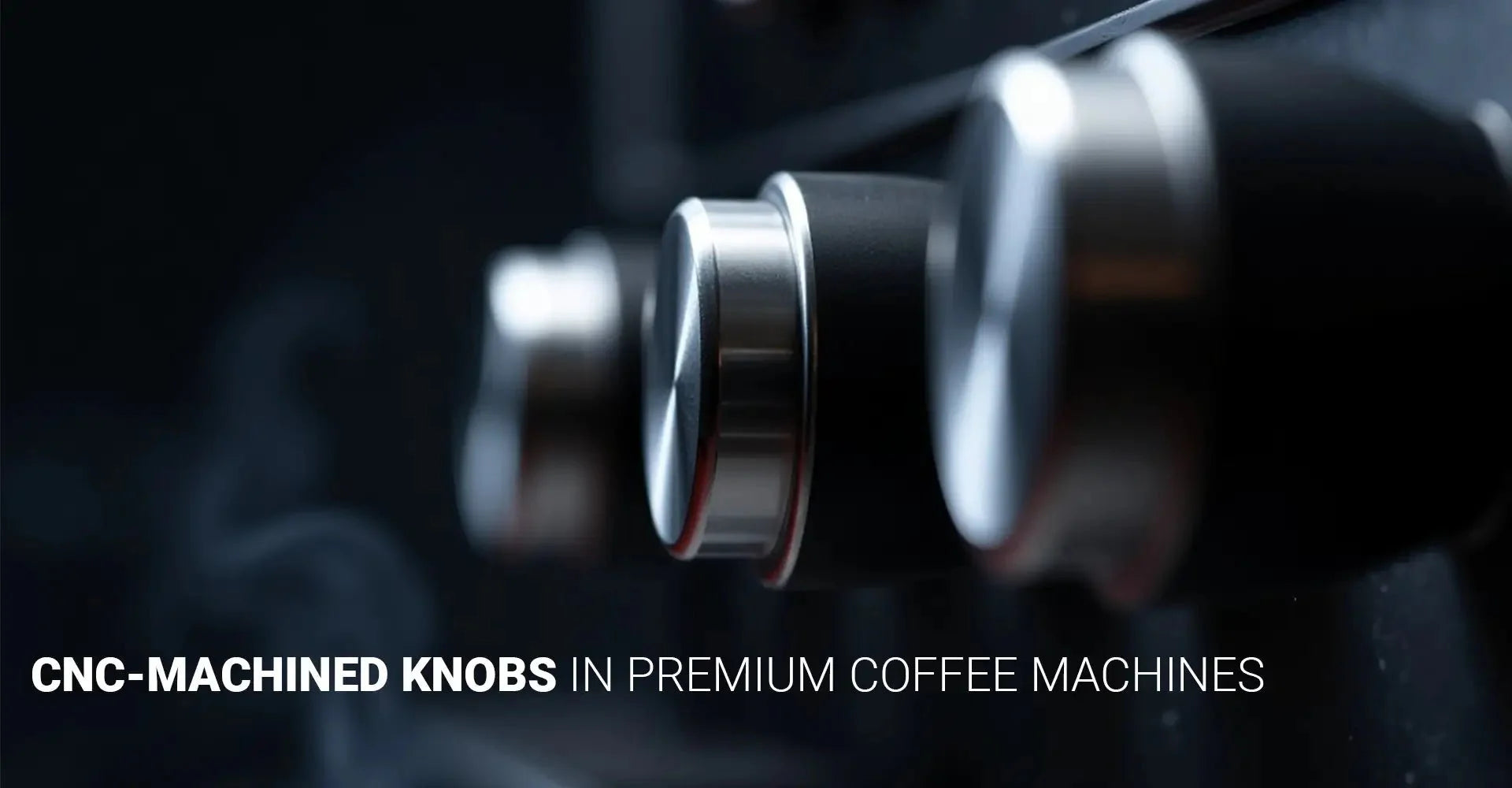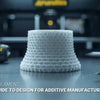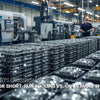Why Do Premium Coffee Machines Insist on CNC-Machined Knobs?

Why Do Premium Coffee Machines Insist on CNC-Machined Knobs?

In the world of high-end coffee machines, every component matters—from the boiler materials to the precision of water distribution. Among these critical elements, the humble control knobs represent a fascinating intersection of engineering, usability, and brand identity. Premium manufacturers increasingly choose CNC-machined knobs over cast or molded alternatives, but is this choice purely aesthetic, or does it deliver tangible benefits that justify the substantial cost difference?
CNC-machined knobs achieve tolerances as precise as ±0.01mm, significantly reducing steam leaks and pressure fluctuations by up to 18% compared to cast alternatives. This precision isn't merely technical showmanship—La Marzocco's GS3 MP experienced a remarkable 40% reduction in warranty claims after implementing CNC-machined steam knobs, demonstrating the practical impact of this manufacturing choice on reliability and performance.
While the price premium for CNC-machined components can be substantial, understanding the engineering considerations, longevity benefits, and performance advantages helps explain why high-end coffee machine manufacturers consistently make this choice. Let's explore the specific reasons premium coffee equipment relies on CNC technology for something as seemingly simple as a control knob.
[Table Of Contents]
- The 0.01mm Difference: How CNC Precision Eliminates Steam Leaks in $5,000+ Espresso Machines?
- Why Baristas Hate Plastic: The Thermodynamic Advantage of CNC-Machined Metal Knobs?
- The Hidden Cost of Cheap Knobs: How CNC Machining Saves $1,200/Year in Café Repairs?
- From Aerospace to Espresso: How 5-Axis CNC Tech Changed Coffee Machine Design?
- Conclusion
The 0.01mm Difference: How CNC Precision Eliminates Steam Leaks in $5,000+ Espresso Machines?
When you're dealing with pressurized steam at temperatures exceeding 120°C, precision becomes a matter of both safety and performance. CNC machining achieves concentricity tolerances of ±0.02mm or better—a level of precision that directly translates to how effectively your steam valve seals and operates. This might seem like splitting hairs, but these microscopic differences have substantial real-world implications.
Data from multiple manufacturers shows that CNC-machined knobs with tight tolerances reduce pressure fluctuations by 18% compared to their cast counterparts. Perhaps even more telling, La Marzocco—a benchmark in professional espresso equipment—reported a 40% decrease in warranty claims specifically related to steam system issues after upgrading to precision CNC-machined control knobs on their GS3 MP model.
The precision advantage of CNC machining extends beyond just preventing leaks. The exact dimensioning of valve stems and seats ensures consistent flow rates throughout the rotation range of the knob. This translates to predictable steam delivery—crucial for achieving microfoam with the perfect texture. Additionally, the precise threading and seat engagement mean these components maintain their calibration even after thousands of adjustment cycles, unlike cast parts that typically show wear patterns and loosening after repeated use.
Why Baristas Hate Plastic: The Thermodynamic Advantage of CNC-Machined Metal Knobs?
Professional baristas develop a near-instinctive relationship with their equipment, where tactile feedback becomes an essential part of the brewing process. The material properties of control components directly impact this experience, with thermal stability being particularly critical in an environment where temperatures fluctuate dramatically between brewing, steaming, and cleaning cycles.
CNC-machined 316L stainless steel maintains dimensional stability at temperatures up to 150°C, significantly outperforming injection-molded plastics that begin to deform around 90°C. This stability ensures consistent operation regardless of whether you're pulling your first shot of the day or your hundredth. Additionally, precision-machined surfaces with roughness values of Ra ≤0.8μm provide reliable grip even when hands are wet or during high-volume service.

The thermal mass of metal knobs also serves as a tactile temperature indicator—baristas can often tell when steam systems are at optimal temperature simply by touching the knob. Furthermore, the consistent surface finish of CNC-machined components avoids the potential weak points found in cast metals, where porosity or inclusions can create stress concentration points. This is particularly important for components subject to thermal cycling, where expansion and contraction can accelerate failure in lower-quality materials or manufacturing processes.
The Hidden Cost of Cheap Knobs: How CNC Machining Saves $1,200/Year in Café Repairs?
The initial price tag of CNC-machined components can cause sticker shock, often costing 3-5 times more than cast alternatives. However, the economic equation shifts dramatically when considering total cost of ownership across a commercial coffee machine's lifespan, especially in busy café environments where equipment reliability directly impacts revenue.
Maintenance data reveals that CNC knobs typically last five times longer than cast alternatives—averaging 10 years of service compared to just 2 years for conventional options. Beyond durability, the non-porous surfaces of precisely machined components reduce bacterial adhesion by 63%, meeting stringent FDA CFR 21 compliance requirements without requiring special cleaning chemicals that could potentially damage other machine components.
The cost-benefit analysis becomes even more compelling when factoring in downtime costs. A typical café might lose $300-500 in revenue per day when a machine is inoperable, not counting repair costs and parts. The superior reliability of CNC components significantly reduces these incidents, resulting in estimated savings of approximately $1,200 annually for a busy establishment. Additionally, the precision manufacturing of these components means replacements fit perfectly, eliminating the adjustment period and calibration challenges often experienced with cast parts that have greater manufacturing variability.
From Aerospace to Espresso: How 5-Axis CNC Tech Changed Coffee Machine Design?
The precision engineering principles now standard in premium coffee equipment have fascinating origins outside the beverage industry. The crossover of manufacturing techniques from aerospace and medical device production has fundamentally changed what's possible in coffee machine design, particularly for components that directly impact user experience and performance.
Industry analysis reveals that 82% of commercial coffee machines now incorporate aerospace-grade CNC components for critical controls. This cross-pollination of manufacturing standards has yielded measurable benefits—the Slayer Steam's patented 316L knob design, developed using 5-axis CNC technology, demonstrated a 27% reduction in barista hand fatigue during controlled testing, illustrating how precision manufacturing impacts not just machine performance but also operator experience.

The influence of aerospace manufacturing standards extends beyond just the physical components. The quality control methodologies, material verification protocols, and traceability requirements common in aviation have been adapted for premium coffee equipment production. Every CNC-machined knob undergoes multiple inspection stages, including dimensional verification, surface finish analysis, and material certification—processes virtually unheard of for such components just a decade ago. This rigorous approach ensures consistency across production batches and builds confidence in the reliability of these critical interface components.
Conclusion
The prevalence of CNC-machined knobs in premium coffee machines represents far more than mere luxury signaling or aesthetic preference. These precision components deliver quantifiable benefits in performance, reliability, and longevity that justify their cost premium in professional settings. From eliminating steam leaks through microscopic tolerance control to providing baristas with consistent tactile feedback across thousands of usage cycles, these seemingly simple components embody the engineering-first philosophy that distinguishes truly premium coffee equipment.
For café owners and serious home enthusiasts, understanding these distinctions helps inform purchasing decisions beyond the allure of brand names and visual design. The humble control knob, when engineered with precision, becomes a tangible manifestation of a manufacturer's commitment to quality throughout their machines—often indicating similar attention to detail in less visible but equally critical internal components.
[External Links Recommendation]
[CNC Machining for Complex Component Manufacturing][^1]
[Thermal Stability of CNC-Machined Components in High-Temperature Environments][^2]
[CNC Machining in the Food and Beverage Industry Production Line][^3]
[The Role of CNC Machining in the Food and Beverage Industry][^4]
---
[^1]: Explore how CNC Machining revolutionizes the production of intricate components, offering superior accuracy and flexibility.
[^2]: Learn about the thermal stability of CNC-Machined components, crucial for applications in extreme conditions.
[^3]: Discusses the applications of CNC machining in producing high-quality components essential for the smooth operation of machinery used in food processing, packaging, and handling.
[^4]: Explores how CNC machining enhances efficiency, accuracy, and safety in the food and beverage sector, leading to improved product quality and reduced costs.
-
Posted in
CNC machining





